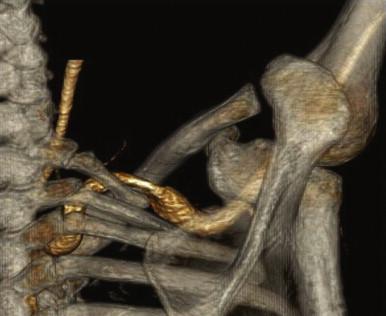Physical Address
304 North Cardinal St.
Dorchester Center, MA 02124
Arterial thoracic outlet syndrome (TOS) can be defined as the anatomic condition that produces pathologic compression of the subclavian or axillary arteries in their course through the thoracic outlet. Arterial compression can occur as an anatomic state in which the artery is externally compressed in neutral position, which with the repetitive motion of the upper extremity accentuates the mechanical stress on the arterial wall, causing its eventual injury. In other cases the artery may not be compressed in neutral position, but the repetitive arm motion suffices to cause the arterial injury. This latter mechanism is likely the culprit of arterial pathology in persons with vigorous upper extremity use, such as athletes or some laborers.
Positional or fixed arterial stenosis at the thoracic outlet, with or without poststenotic arterial dilatation, is the precursor of aneurysm formation. The development of arterial dilation is secondary to arterial wall vibration from turbulent flow dynamics, but it may be reversible following resolution of the stenosis. The natural history and clinical significance of arterial compression in patients with TOS is not well known, but in many cases it is not benign. During the early stages of arterial TOS, the artery is histologically intact, showing external compression only during arm motion, typically with arm elevation. Eventually, this dynamic compression results in post-stenotic dilatation and eventually aneurysmal degeneration of the wall. In other cases, the arterial injury results in intimal thickening and disruption that can produce fixed arterial stenosis, occlusion, or embolic phenomena.
Arterial TOS is considered the least common form of TOS and is estimated to constitute less than 5% of all TOS cases. However, the incidence of arterial TOS is probably underestimated because its diagnosis is rarely suspected unless it manifests with an ischemic complication. The University of Michigan experience with more than 400 cases of TOS revealed 17% to be the arterial type.
The subclavian artery is typically compressed as it courses between the first rib inferiorly, the anterior scalene muscle anteriorly, and the middle scalene muscle and the brachial plexus posteriorly. Arterial TOS occurs much less commonly as a result of compression of the axillary artery by the pectoralis minor muscle anteriorly or by the humeral head posteriorly. The fact is that most cases of arterial TOS are associated with the presence of cervical ribs, anomalous first ribs, or deformities secondary to clavicular or rib fractures or orthopedic surgery.
Complete cervical ribs typically elevate the floor of the thoracic outlet, significantly increasing the compression of the subclavian artery by the anterior scalene muscle ( Figure 1 ). Cervical ribs are found in less than 0.5% of the general population, and are twice as common in women as in men. Their presence is associated with histopathologic changes in the brachial plexus, including fibrosis, vascular hyalinization, mucinous degeneration, and intraneural collagen nodules. Changes are not seen in nerve specimens of patients without cervical ribs. This observation suggests that in cases of arterial compression by a cervical rib, nerve compression is likely also present.

The incidence of cervical ribs reported in large surgical series of neurogenic TOS is between 4% and 5%. In my experience with patients operated on for all types of TOS, the overall incidence of cervical rib or other bony anomaly was 25%, whereas it was 60% among patients with arterial TOS. This difference might reflect practice referral patterns, but may be a result of more stringent surgical criteria for neurogenic TOS.
Become a Clinical Tree membership for Full access and enjoy Unlimited articles
If you are a member. Log in here